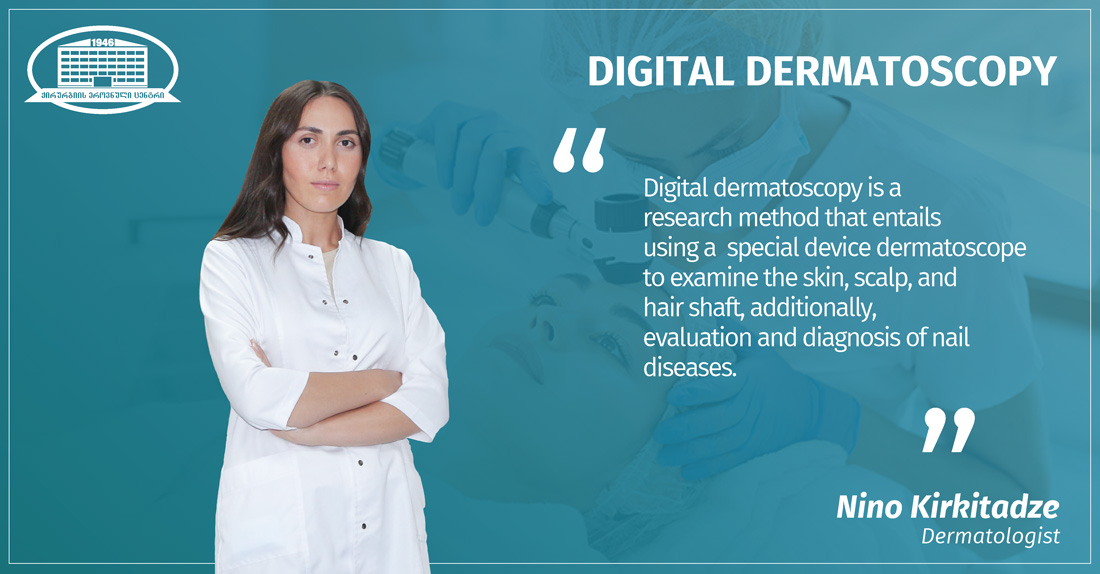
The National Center of Surgery’s Digital Technologies - DERMLITE DL4
The digital dermatoscopy, what about it?
-Using a specialized instrument called a dermatoscope, the skin, scalp, hair shaft structure, as well as nail problems, are assessed and identified in this study approach. There is no discomfort involved and no need for preparation before the treatment. Any skin issue, including rashes, patches, and disorders that cause hair loss (alopecia), is diagnosed through research. The gold standard for detecting skin cancer, this diagnostic approach makes it easier to distinguish between pigmented and non-pigmented, benign and malignant formations.
What distinguishes a digital dermatoscope from a traditional magnifier?
-Unlike a magnifying glass, which only allows us to see the skin's surface, a dermoscope allows us to examine the forms' intricate structural details. For instance, using a dermoscope, we can see abnormal pigment networks, abnormal blood arteries, abnormal regression foci, etc. in melanomas. With a traditional magnifying glass, this is not possible. The dermatoscope, which differs from a traditional magnifier in that it has a high-quality magnifying lens and both polarized and non-polarized light, enables visualization of the skin's surface structures ten times more completely and deeply, including in the epidermis, dermo epidermal border, and papillary dermis.
When is it essential to perform a dermatoscopic examination, and why is it performed for that purpose?
-Digital dermoscopy is already essential to modern dermatology. A dermatologist must use a dermatoscope to examine any new or existing skin growths whose shape, color, or boundaries have altered in order to prevent potential consequences. Since dermoscopy helps us distinguish between benign and malignant growths, fewer unnecessary biopsies are required. For instance, some safe formations are merely cosmetic defects and don't need to be eliminated, other malignant tumors require immediate surgical intervention.
What conditions are diagnosed through dermatoscopy?
- In regular dermatological practice, dermatoscopy is an excellent screening technique. Essentially, it is done to identify the following skin conditions:
- Melanoma;
- Basal cell carcinomas of the skin;
- Squamous cell carcinomas;
- Seborrheic keratosis;
- Dermatofibroma;
- Hemangioma.
It is used to identify infectious and inflammatory skin disorders, such as mycoses, discoid lupus erythematosus, red lichen planus, and psoriasis. In the course of disorders like vitiligo and melasma that have a pigmentation disorder. To identify warts, Molluscum contagiosum, and hair and scalp conditions in the case of viral dermatoses.
Describe how a dermatoscopic examination is carried out…
-The digital research approach stands out for being straightforward, non-invasive, and completely painless. The dermoscopic image that is automatically captured when the device is placed on the skin's surface serves as the basis for the diagnosis and makes it simpler to distinguish between various dermatoses. Additionally, because the device has the capability of taking pictures, saving them as digital images, and comparing them to later data, diseases can be continuously monitored.
What complaints are the foundation for a dermatologist's dermatoscopic examination?
-Patients come to us mostly for help diagnosing moles that have changed in size, color, or border. If the growth has a moist, non-healing surface or has turned bloody (ulcer that does not heal). To identify disorders that cause hair loss (alopecia). Dermatoscopy is used to determine the kind of alopecia and whether it takes an active or passive course. This enables us to choose the best course of treatment and make an accurate diagnosis. In the course of diseases with a disruption of pigmentation, the following complaints are frequently mentioned:
- Brown spots in the face area;
- White spots on the body.
An reliable diagnosis of spots can be made with a digital dermoscope. identification of the condition's nature, including whether it is acquired, infectious, or autoimmune in origin.
Tell us about the DERMLITE DL4 machine's technical features and benefits…
- The Dermlite DL4 dermoscope, which is part of the fourth generation, is the most advanced model of portable dermoscopes and stands out for having the highest quality digital image. A 30mm lens with polarized/non-polarized lights provide us a wider field of view and a better representation of deep pigmentation. The infection control disposable headgear offered by DL4's epidemiology system IceCap shields the patient from cross-contamination during device-to-skin contact. By taking a picture of a digital image, the DERMLITE dermatoscope makes it possible to continuously monitor the formations.
Call us at the hotline numbers +995 577 119 119 or +995 322 02 25 25 to schedule an appointment with a dermatologist in advance.
Wish you health!







